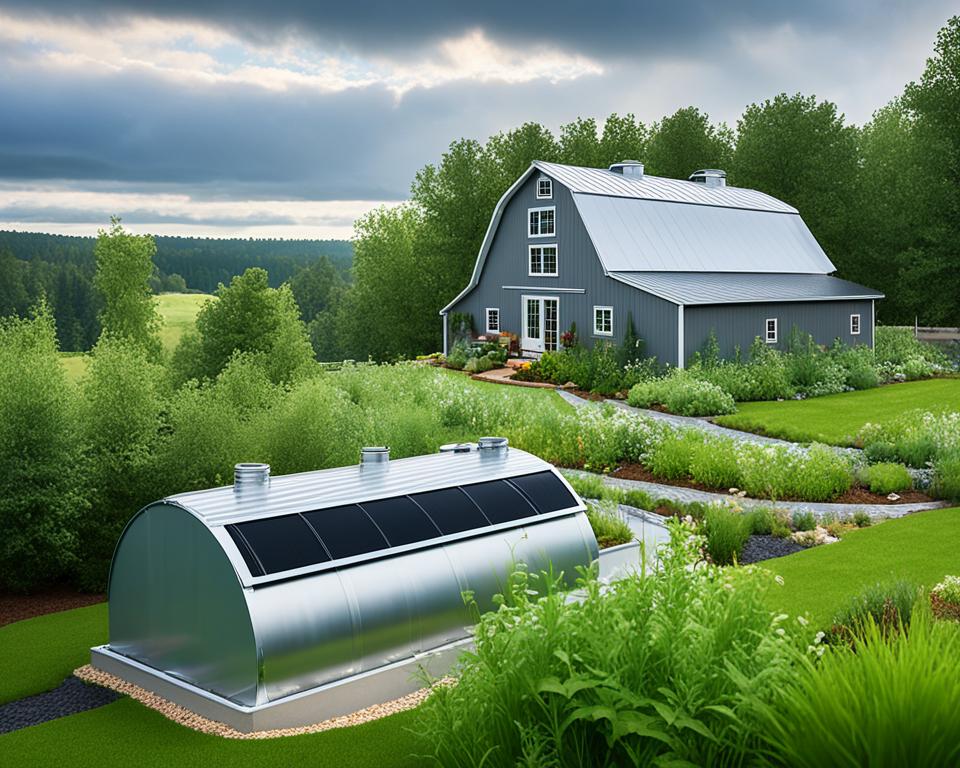I’ve always been drawn to small changes that make a big difference. Rainwater harvesting changed how I use water. It’s not just good for the planet; it’s a step towards being self-sufficient and caring for our environment.
In our world, saving natural resources is key. Using a rainwater collection system can really help. This guide is not just a how-to book. It’s a way to start living sustainably, drop by drop.
What is Rainwater Harvesting?
Rainwater harvesting is a way to save water and manage it sustainably. It’s been around since ancient times, used by the Romans and Mayans. Now, it’s a modern way to get eco-friendly water.
How Rainwater Harvesting Works
This method is easy and can be used at home. Here’s how it works:
- Collecting rainwater from a roof through gutters and downspouts.
- Using a first flush diverter to keep the water clean by skipping the first flow.
- Storing the water in tanks or cisterns.
- Using the water for things like watering plants, washing cars, or other non-drinking uses after cleaning it.
Rainwater harvesting shows how powerful Rainwater Collection Systems, Sustainable Water Management, and Environmental Sustainability can be. It helps homeowners use less city water, save water, and help with water recycling in their areas.
“Rainwater harvesting is a simple, yet profoundly effective method of collecting and storing rainwater for future use.”

Benefits of Rainwater Collection Systems
Rainwater collection systems have many benefits. They help save water, protect the environment, and save money. They are great for homeowners and communities.
These systems reduce the strain on groundwater and surface water. They keep the natural water cycle going. This helps protect local water from pollution and overuse.
Collecting rainwater can also save you money on your water bill. You can use it for things like watering plants, washing cars, and cleaning toilets. This means you use less expensive city water.
- Alleviates stress on local water ecosystems
- Promotes water conservation and sustainable water management
- Reduces water bills through the use of collected rainwater
- Mitigates the impact of stormwater runoff in urban areas
- Enhances water security and availability, especially in water-scarce regions
- Leads to energy savings by reducing the need for energy-intensive water treatment and transportation
Rainwater collection systems help with stormwater runoff in cities. Too much runoff can cause erosion, pollution, and flooding. These systems store rainwater, easing the load on city drainage and protecting the environment.
In places with little water, collecting rainwater is very useful. It adds to the water supply, especially when it’s dry. It also saves energy by cutting down on the need for treating and moving city water.
Using a rainwater collection system is a step towards a greener life. It shows care for the planet and smart water use. It’s a simple way for people and communities to help the environment.

Implementing a Rainwater Collection System
Setting up a rainwater collection system is easy and boosts your home’s water use. It has several parts like the roof, gutters, downspouts, a first-flush diverter, tanks, filters, and a way to distribute the water.
Storage tanks hold the rainwater for later use. They can be small barrels or big cisterns. It’s important to clean and purify the water before using it inside. This makes sure the water is safe and clean.
Rainwater collection systems are very useful. You can use it for watering plants, cleaning, flushing toilets, and even drinking. By using a rainwater collection system, you use less city water. This helps with water conservation and is good for the environment.

